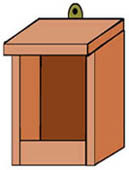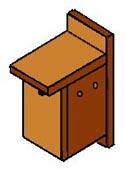Backyard Bird Stuff
Eric Actually inspired this post with yesterday's advisory on hummingbirds. We just recently got back into backyard birding after a lengthy hiatus. It was nice to see others are intersted in the same thing.
We used to be avid bird watchers, feeders and homegivers years ago, before we adopted some kittens. Naturally, after the kittens were here, the birds got rather scarce. We used to have sometimes up to a couple hundred birds in our two apple trees at times, or so I figured one day after making a rough estimate.
We started out just by putting out a bird feeder, bought at a local store. It might have been Pierson's. Then I went one step further and started making birdhouses. At least one of the birdhouses was quite successful.
********
For feeding, at first we used the standard bird seed blend you find just about anywhere; A few sunflower seeds mixed with millet, thistle and whatever. That turned out to be not only expensive but wasteful. Most birds seems to prefer the sunflower seeds and would ignore the rest. I found it made much more sense to buy black oil type sunflower seed in fifty pound bags that I found at Nielsen Company in Eureka.
That worked well. About the only problem to keep an eye out for is rodents. I used to feed birds by placing seed on top of a fence when I lived in Myrtletown until one night I was outside and noticed a big brown rat scurry along the top of the fence and start eating the bird seed. That put an end to bird feeding there.
Connie just started feeding the birds again a couple weeks ago after we noticed their usual congregating in the yard as they do in the dead of winter. The robins seem to come in mass whenever it gets real cold and they really raise hell in the yard. There's probably twenty or thirty in the back yard as I write this.
Along with the robins came some more solitary birds like warblers and fox sparrows, although some of them have actually been hiding in the yard all along. The robins don't eat normal bird food, but some of the other ones do so Connie tried feeding them, at first just using some seeds of various types she had around the house but that certainly couldn't last for long.
So, I went to Rite Aid and bought a small bag of sunflower seed that should do for the time being. We have an upside down garbage can in the back yard she puts the seed on. Perfect place to watch the birds from and, hopefully, the rats won't be able to climb up there.
Some bird people recommend suet in the winter for birds. That's fat of various kinds, usually mixed with seed. I never had much luck with it. You can buy suet blocks already prepared. I figured it make more sense to make my own.
I went to the meat department of a local grocery store and just asked for any waste meat they had. That usually has a lot of fat with it. I'd take it home and cook the oil out of it and, while still warm so it wouldn't congeal, mix it with normal commercial bird seed mix and set it in the fridge to let it set.
That was probably more trouble than it was worth. Not only was it a mess to have to render the fat, I don't recall any significant attention it got from the birds. I gave up on it. Maybe the commercially available suet blocks would work better. I don't know.
********
Of course, there's also the hummingbirds that got me started on this thread.
We started with hummer feeders years ago, using the standard store bought feeders. They worked fine, except for one big one I bought. It was a huge egg- shaped thing that must of held a quart of sugar water. I liked it because I didn't have to refill it that often.
One problem, though: It didn't have bee guards. Those are the little screen type things that fit over the feeder holes to keep bees and yellow jackets from going for the sugar water. I'd read of the need for the guards but never had a problem until a few months after I started using the egg- shaped feeder.
We couldn't figure out why the hummers stopped using it all of the sudden. Upon closer inspection there were all kinds of yellow jackets feeding at it and the hummers knew enough to stay away from them.
We went back to the old feeders with guards on them, but soon stopped feeding altogether as our newly acquired cats chased most of the birds away anyway. The feeders eventually broke and we never replaced them until Connie got a couple of glass feeders as a gift a few years ago.
She hung the big one up in the apple tree but for some reason no hummers came around. She had a smaller one that looks kinda like a flower that she put just outside the back door. We'd started seeing at least one hummer hanging around lately so she filled up the one at the back door. It started feeding from it, not seeming to pay any attention to the one in the apple tree to this day.
This is one friendly hummer. It goes to the feeder all the time, even when the cats are nearby. It seems to make a special trip to the feeder whenever we go out the back door. Either it feels safer with us there, or maybe it's trying to show us she's using it so we'll keep the feeder full? I don't know. It was so close to me the other day I could have grabbed it. Fun bird.
When the weather warms up and the bugs come out we'll have to see if the yellow jackets are a problem with this feeder. They didn't come with bee guards but I suppose we could improvise something.
***********
I got into building birdhouses back in our bird feeding heyday, however long ago that was. I bought a book on birdhouses that showed different designs for different birds.
A lot of the birdhouses you see sold at stores are really only suitable for ornamental purposes. Different birds like different dimensions to their homes and prefer their homes within a certain distance from the ground.
I thought the book I bought on birdhouses was one of the Ortho series of books but maybe my memory fails me. I couldn't find it in the storage room but found another one from a different publisher. Never mind about that as there's plenty of info available online for building birdhouses, like this site.
I built a few different styles. First was a nesting shelf, or whatever it was called, for robins. I put one up on the south side of the storage room about ten foot high,
 just under the eaves of the roof. It sat there for years unused. I finally took it down when we repainted the house. It must have been too close to human activity for the robins to feel safe with it. Or, maybe robins just want to eat in our back yard, not live in it.
just under the eaves of the roof. It sat there for years unused. I finally took it down when we repainted the house. It must have been too close to human activity for the robins to feel safe with it. Or, maybe robins just want to eat in our back yard, not live in it.Since we had a whole bunch of sparrows around, I put a sparrow house up on the east side of the house by the corner near an upstairs window and, again, just under the eaves of the roof. Seems to me I saw a sparrow interested in at one point but he or she never settled in. It sat there for years unused until, just like the robin's nesting shelf, I took it down when we repainted the house.
The real success was my chickadee house. I built one, then another, to the proper specs. I put one up on the north side of one of the apple trees, with it tilting at a slight
 downward angle as I'd read was preferred by chickadees. Did the same thing with the second one on the north side of one of our chestnut trees.
downward angle as I'd read was preferred by chickadees. Did the same thing with the second one on the north side of one of our chestnut trees.I put those out in late winter or early spring. Within a week or two I could see a chickadee taking the makings of a nest to the house on the chestnut tree. How cool!
That house hosted chickadeess three years in a row, if memory serves me correct.
The birds finally seemed to get leery of it, perhaps because some of the cats were trying to work their way up there, or maybe it was because I let the ivy grow up the tree until it got to almost covering the birdhouse. Either way, they gave up on it.
The one house on the apple tree never ended up with any chickadees, although I did see one start a nest one year. The cats chased that one away, I'm pretty sure.
Both those houses are still up there but can barely be seen from all the ivy growing up the trees. I'm working now to sever the ivy at the bottom of the tree so it doesn't grow any higher. Maybe I'll see if I can get the one on the chestnut tree to get some chickadees in it this year.
***********
A couple hints about birdhouses, in case the web sites don't mention it:
You often see commercial birdhouses with a little dowel below the "door" that the bird can supposedly use as a perch. Don't do that. Birds don't need it and it can actually give predators a helping hand into the birdhouse.
Make some accomodation to allow cleaning out of the birdhouse after the birds leave. If you leave the old nest in there, a new pair of birds the next year might think it's already occupied and look elsewhere for their nesting place.
Both of mine have small hinges on the front panels, so they open like a door, and one of those hook and eye type latches to lock it closed. Worked well enough.
********
So, maybe we'll get back into this bird thing again. Oddly enough, our two kittens seem to have lost interest in birds over the years. One of them would catch one on occasion and Miss Kitty still comes to attention sometimes when she sees one, but neither of them seem to have the energy to go stalking them.
Cloney, our half cat- the cat that must live somewhere but seems to spend most of his time in our back yard- seems to not care at all about the birds.
Maybe it would be worthwhile to keep feeding and we won't have too many casualties.
Then again, even before we had our own cats, the neighborhood cats would get wind of our bird sanctuary and they'd become regulars in the backyard, in search of prey. let's hope our lazy cats are enough to keep the more energetic ones away.


11 Comments:
This post is for the birds.
Birds of a feather...
Fred I never knew you had a soft spot for birds, How cute! Remember though, don't pet them too hard Fred. I know you like the pretty birds but you can hurt the birds if you pet them too hard!
I used to do the very same thing, Fred, go to the meat markets and get their scraps and render them down.
That was too smelly and messy, so I started buying shortening or lard in the 3-pound cans. Much easier that way.
Then I would melt that fat in a pot, and add 1 cup of brown sugar, 1 cup of quick oats, 1 cup of Polenta meal, and 1/4 cup Crushed red pepper flakes, then cool and keep stirring till it thickens.
Then I use old plastic margarine tubs and fill each one about 2/3 full and put them into the refrigerator to cool some more.
I've been doing this for the past 10 years, and the birds love it.
And since we love watching and taking pictures of the birds, everyone here is happy with the results.
Martha Sargent’s Sure-Fire Bird Mix: (suet)
1C crunchy peanut butter
1C lard
2C ‘quick cook’ oats
2C cornmeal
1C white flour
1/2 C sugar
Melt the lard & peanut butter separately in stove-top pan or microwave. Stir in other ingredients. Pour into square container about 2” thick. Store in freezer. Will NOT melt in warm weather.
Gee, now why didn't I think of that: Lard.
"Gee, now why didn't I think of that: Lard."
Forget it Fred. Kalifornia is soon to adopt the Cuban model of rationing lard and cooking oil. This is a two front battle to fight obesity in birds and humans (for their own good). All of those birds in Texas and Australia have wound up dead from high cholesterol. By completing form HC 35-286 stating the extra coupons will only be used for birds you may receive extra stamps but you must file quarterly reports with Sacramento.
Great post, Fred.
Our Corgi loves chasing and barking at the birds. They like to tease him back. The birds of prey swoop down at him considering him maybe too loud and too big for breakfast.
Do you guys really think you live in a highly regulated society? Try living in any other westernized industrial society and I think you will understand were doing just fine. Being a critic of government is easy. Hell, its an American tradition, but don't be lazy about it.
Carol wrote,"The birds of prey swoop down at him considering him maybe too loud and too big for breakfast.".
What always gets me is in the spring time when the birds are nesting. You'll see a house cat strolling through the yard and a bird will swoop down, grab some of his fur and take off, repeating the attack as soon as he's done putting the fur in his nest.
I always wondered why the cats don't try and fight back?
9:46 am: Yep, been there, done that. We'll do just fine as long as we are successful in resisting the programs proposed by the idiots in Sacramento and DC. Being lazy is accepting the collectivist crap without having bothered to see it in action. Read a few of Daniel's posts from Venezuela at http://daniel-venezuela.blogspot.com/
Post a Comment
<< Home